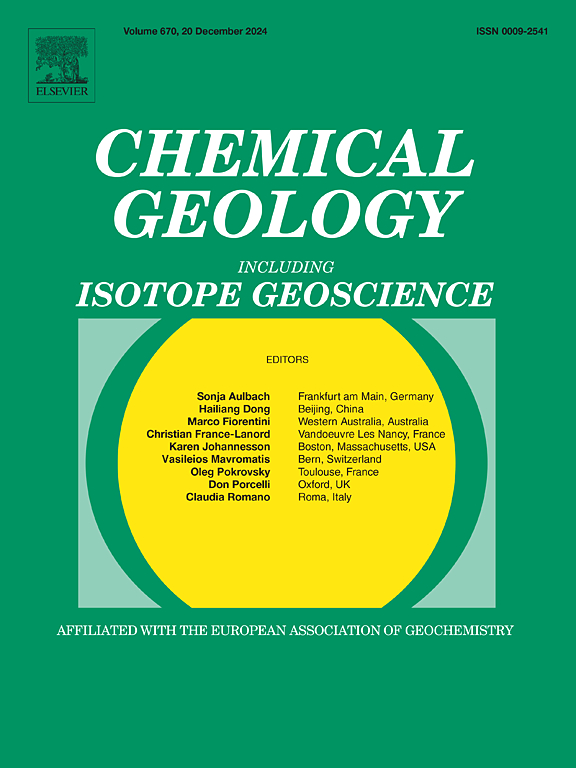蒸发岩在瑞典北部北博滕地区基鲁纳型氧化铁磷灰石矿床中的作用:来自镰状石原位卤素分析的证据
IF 3.6
2区 地球科学
Q1 GEOCHEMISTRY & GEOPHYSICS
引用次数: 0
摘要
盐水液体或盐熔体最近被认为在形成kiruna型氧化铁磷灰石(IOA)矿床中起关键作用,沉积蒸发岩被认为是成矿过程的贡献者。然而,人们对蒸发岩在成矿中的时间和作用知之甚少。水含盐流体(也称为高盐流体)与岩石相互作用产生的钠蚀变的典型产物——角长石矿物,可能为了解矿石成因提供关键线索。在这里,我们测量了两个具有代表性的IOA矿床(Mertainen和Gruvberget-Fe)和瑞典北部Norrbotten地区的Aitik斑岩Cu系统的石榴石的原位Cl/Br比值,以追踪矿相关液体的来源和演化。根据矿物组合,scalalite颗粒可分为Scp I和Scp II。Scp I形成于前矿蚀变或同矿蚀变过程中,具有明显的摩尔Cl/Br比值(510-2000)。这种变化意味着伴生液体的多种来源,尽管主要是岩浆来源。分带的Scp I晶体显示出相对较低的Cl/Br比值,在其核心中为510-790,在地幔和/或边缘中增加到730-1640。这一趋势表明,颗粒最初主要与孔隙水(卤水和/或海水)平衡,但后来主要受到岩浆源液体的缓冲。Scp II与赤铁矿作用有关,具有更高的摩尔Cl/Br比(2300-3500),可能来自基律纳绿岩群含岩盐的蒸发溶蚀流体。研究结果表明,蒸发岩组分主要是通过岩浆侵入引发的流体循环进入所研究的IOA体系。然而,后期蒸发岩溶蚀流体覆盖在矿系上,可能会使人误以为蒸发岩溶蚀流体在成矿过程中起了关键作用。本文章由计算机程序翻译,如有差异,请以英文原文为准。
The role of evaporites in Kiruna-type iron oxide-apatite deposits in the Northern Norrbotten region, Sweden: Evidence from in situ halogen analyses of scapolite
Hydrosaline liquids or salt melts have recently been suggested to play a key role in forming Kiruna-type iron oxide-apatite (IOA) deposits, with sedimentary evaporites proposed as contributors to ore-forming processes. However, the timing and role of evaporites in ore formation are poorly understood. Scapolite minerals, typical products of sodic alteration resulting from the interaction between hydrosaline liquids (also called highly saline fluids) and country rocks, may provide key insights into ore genesis. Here, we measured in situ Cl/Br ratios of scapolite from two representative IOA deposits (Mertainen and Gruvberget-Fe) and the Aitik porphyry Cu system from the Northern Norrbotten region of Sweden to trace the sources and evolution of ore-related liquids. Based on mineral assemblages, scapolite grains are classified into Scp I and Scp II. Scp I, formed during pre-ore or syn-ore alteration, exhibits distinct molar Cl/Br ratios (510–2000) across domains and grains. This variation implies multiple, though dominantly magmatic, sources for the associated liquids. Zoned Scp I crystals show relatively low molar Cl/Br ratios of 510–790 in their cores, increasing to 730–1640 in the mantles and/or rims. This trend suggests that the grains initially equilibrated with dominantly pore waters (bittern brines and/or seawater) but were later primarily buffered by liquids of magmatic origin. Scp II, associated with hematitization, have much higher molar Cl/Br ratios (2300–3500) and likely precipitated from halite-bearing evaporite-dissolution fluids derived from the Kiruna Greenstone Group. Our findings suggest that evaporite components were introduced into the studied IOA systems primarily through fluid circulation triggered by magmatic intrusion. However, later-stage evaporite dissolution fluids overprinting the ore system may create the misleading impression that evaporite-derived fluids played a key role in ore genesis.
求助全文
通过发布文献求助,成功后即可免费获取论文全文。
去求助
来源期刊

Chemical Geology
地学-地球化学与地球物理
CiteScore
7.20
自引率
10.30%
发文量
374
审稿时长
3.6 months
期刊介绍:
Chemical Geology is an international journal that publishes original research papers on isotopic and elemental geochemistry, geochronology and cosmochemistry.
The Journal focuses on chemical processes in igneous, metamorphic, and sedimentary petrology, low- and high-temperature aqueous solutions, biogeochemistry, the environment and cosmochemistry.
Papers that are field, experimentally, or computationally based are appropriate if they are of broad international interest. The Journal generally does not publish papers that are primarily of regional or local interest, or which are primarily focused on remediation and applied geochemistry.
The Journal also welcomes innovative papers dealing with significant analytical advances that are of wide interest in the community and extend significantly beyond the scope of what would be included in the methods section of a standard research paper.
 求助内容:
求助内容: 应助结果提醒方式:
应助结果提醒方式:


